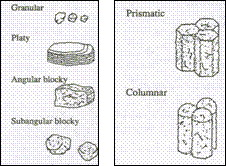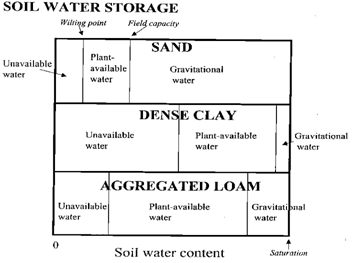Competency Area 2: Soil hydrology AEM
PO 12. Know the relationship between soil water content, soil water tension and soil pore size and the following soil parameters (and qualitatively understand how these parameters vary for different soil types) and their relationships to plant growth and the fate and transport of nutrients and pesticides.
- Field Capacity
- Permanent Wilting Point
- Available Water Capacity
- Total Soil Water Storage Capacity
- Drainable Porosity
- Soil Texture and Structure
- Macroporosity/Preferential Flow
|
Soil Texture and Structure The size and percentage of individual soil particles determines a soil's texture, but when the bulk arrangement of these particles is considered, the term structure is used. The clustering or aggregation of primary soil particles into compound particles of naturally formed peds or separate soil aggregates can greatly modify the textural influence on soil air and moisture relationships. The soil texture and structure fundamentally determines the number and sizes of soil pores, which will influence the fate and transport of air (gas) and water exchange. Various soil forming processes lead to natural structural features, and soil scientists classify these into the types shown below. Pores exist around these structure types, and some (i.e., crumb, subangular blocky) will also contain smaller micro-pores within the aggregate or ped. A platy structure usually impairs permeability because the horizontal plates often overlap, but a blocky structure may lead to even larger pore sizes than would be found between individual soil particles. The blocky structure is important in clay soils, and is generally what provides the drainable porosity. |
|
|
image source: NRCCA Soil and Water Management Study Guide |
Soil structure can be modified naturally by soil microorganisms. The effect of worm burrows in forming macropores is perhaps best known because it can be easily visualized. However, modern tillage implements also greatly modify the soil structure within, and sometimes below (plowpan), their range of depth influence. The following figure provides an illustration of how various parameters of soil water storage may be influenced by different texture and structure aspects (From H.M. van Es). |
|
images' source: NRCCA Soil and Water Management Study Guide |
|
Quick Links
- Competency Area 1: Basic soil properties
- Competency Area 2: Soil hydrology AEM
- Competency Area 3: Drainage and irrigation AEM
- Competency Area 4: Soil health and compaction
- Competency Area 5: Soil conservation AEM
- Competency Area 6: Watershed hydrology AEM
- Competency Area 7: Non-point source pollution AEM
- Competency Area 8: Concentrated source pollution AEM
- Competency Area 9: Conservation planning AEM


